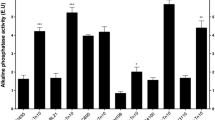Summary
Derivatives of λpF13 phage in which lacZ expression (β-galactosidase synthesis) is directed by transcription initiated at a heat-shock promoter (PrpoD hs or PgroE) were constructed and used for analysis of the heat-shock response in Escherichia coli. A wild-type strain (MC4100) lysogenic for either of these phages exhibited typical transient induction of β-galactosidase synthesis upon a temperature shift from 30° to 42° C or after addition of ethanol to the medium (4% to 5%) at 30° C. In contrast, most amber rpoH (htpR) mutants tested (in a Su- background) failed to respond to a temperature shift, though some mutants affected in the carboxy-terminal region exhibited a partial response. All rpoH mutants tested showed a weak but significant response to ethanol. F′ plasmids carrying each of six known nonsense suppressors were then introduced into each of four rpoH amber mutants lysogenic for λpF13-(Phs-lacZ), creating a set of F′ strains that produce sigma 32 protein with a specific amino acid substitution at a known site. Some of these strains showed an essentially normal heat-shock response while others showed little response with either or both of the promoters. In some instances, the response was significantly delayed. These results point to the usefulness of the λpF13-derivative phages for quantitative and systematic analysis of heat-shock response in E. coli.
Similar content being viewed by others
References
Casadaban M (1976) Transposition and fusion of the lac gene to selected promoters in Escherichia coli using bacteriophage lambda and mu. J Mol Biol 104:541–555
Casadaban MJ, Cohen SN (1980) Analysis of gene control signals by DNA fusion and cloning in Escherichia coli. J Mol Biol 138:179–207
Cooper S, Ruettinger T (1975) A temperature sensitive nonsense mutation affecting the synthesis of a major protein of Escherichia coli K12. Mol Gen Genet 139:167–176
Cowing DW, Bardwell JCA, Craig EA, Woolford C, Hendrix RW, Gross CA (1985) Consensus sequence for Escherichia coli heatshock promoters. Proc Natl Acad Sci USA 82:2679–2683
Grossman AD, Erickson JW, Gross CA (1984) The htpR gene product of E. coli is a sigma factor for heat-shock promoters. Cell 38:383–390
Grossman AD, Zhou Y-N, Gross C, Heilig J, Christie GE, Calendar R (1985) Mutations in the rpoH (htpR) gene of Escherichia coli K-12 phenotypically suppress a temperature-sensitive mutant defective in the σ70 subunit of RNA polymerase. J Bacteriol 161:939–943
Hirano M, Shigesada K, Imai M (1985) Expression vector systems for cloning and systematic analysis of transcriptional regulatory signals in Escherichia coli. Cell Technology 4:781–791
Hunter MG, Glass RE (1982) Analysis of btuB receptor function by use of nonsense suppression. J Bacteriol 151:1591–1594
Landick R, Vaughn V, Lau ET, VanBogelen RA, Erickson JW, Neidhardt FC (1984) Nucleotide sequence of the heat shock regulatory gene of E. coli suggests its protein product may be a transcription factor. Cell 38:175–182
Lemaux PG, Herendeen SL, Bloch PL, Neidhardt FC (1978) Transient rates of synthesis of individual polypeptides in E. coli following temperature shifts. Cell 13:427–434
Matsumoto Y, Shigesada K, Hirano M, Imai M (1986) Autogenous regulation of the gene for transcription termination factor rho in Escherichia coli: Localization and function of its attenuators. J Bacteriol 166:945–958
McKenney K, Shimatake H, Court D, Schmeissner U, Brady C, Rosenberg M (1981) A system to study promoter and terminator signals recognized by Escherichia coli RNA polymerase. In: Chirikjian JG, Papas TS (eds) Gene amplification and analysis, vol 2. Structural analysis of nucleic acids. Elsevier, Amsterdam, pp 383–415
Miller JH (1972) Experiments in molecular genetics. Cold Spring Harbor Laboratory, New York
Neidhardt FC, VanBogelen RA (1981) Positive regulatory gene for temperature-controlled proteins in Escherichia coli. Biochem Biophys Res Commun 100:894–900
Osawa T, Yura T (1981) Effects of reduced amount of RNA polymerase sigma factor on gene expression and growth of Escherichia coli: Studies of the rpoD40 (amber) mutation. Mol Gen Genet 184:166–173
Stüber D, Bujard H (1982) Transcription from efficient promoters can interfere with plasmid replication and diminish expression of plasmid specified genes. EMBO J 1:1399–1404
Taylor WE, Straus DB, Grossman AD, Burton ZF, Gross CA, Burgess RR (1984) Transcription from a heat-inducible promoter causes heat shock regulation of the sigma subunit of E. coli RNA polymerase. Cell 38:371–381
Tobe T, Ito K, Yura T (1984) Isolation and physical mapping of temperature-sensitive mutants defective in heat-shock induction of proteins in Escherichia coli. Mol Gen Genet 195:10–16
Wada C, Akiyama Y, Ito K, Yura T (1986) Inhibition of F plasmid replication in htpR mutants of Escherichia coli deficient in sigma 32 protein. Mol Gen Genet 203:208–213
Yamamori T, Ito K, Nakamura Y, Yura T (1978) Transient regulation of protein synthesis in Escherichia coli upon shift-up of growth temperature. J Bacteriol 134:1133–1140
Yamamori T, Yura T (1980) Temperature-induced synthesis of specific proteins in Escherichia coli: Evidence for transcriptional control. J Bacteriol 142:843–851
Yamamori T, Yura T (1982) Genetic control of heat-shock protein synthesis and its bearing on growth and thermal resistance in Escherichia coli K-12. Proc Natl Acad Sci USA 79:860–864
Yura T, Tobe T, Ito K, Osawa T (1984) Heat shock regulatory gene (htpR) of Escherichia coli is required for growth at high temperature but is dispensable at low temperature. Proc Natl Acad Sci USA 81:6803–6807
Yura T, Yamamori T, Osawa T (1983) Transcriptional control of heat shock inducible operons in Escherichia coli. In: Schlessinger D (ed) Microbiology 1983. American Society for Microbiology, Washington, DC
Author information
Authors and Affiliations
Additional information
Communicated by K. Isono
Rights and permissions
About this article
Cite this article
Yano, R., Imai, M. & Yura, T. The use of operon fusions in studies of the heat-shock response: Effects of altered sigma 32 on heat-shock promoter function in Escherichia coli . Mol Gen Genet 207, 24–28 (1987). https://doi.org/10.1007/BF00331486
Received:
Issue Date:
DOI: https://doi.org/10.1007/BF00331486




